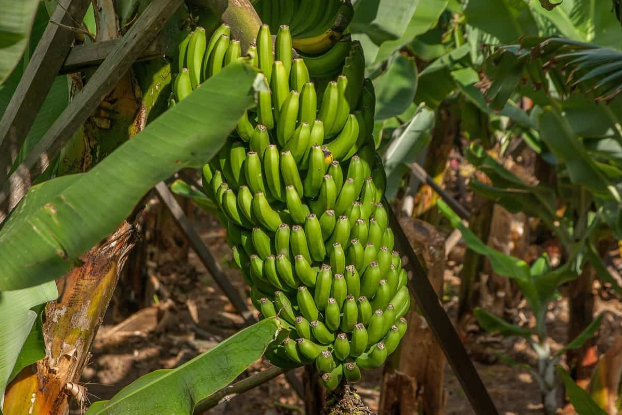Vaazhai, or banana, is one of the most beloved plants in the world. It is not only enjoyed for its delicious fruit but also revered for its leaves, flowers, and even its trunk. The banana plant is native to Southeast Asia but has spread to many parts of the world, making it a significant part of diets and cultures. The word “Vaazhai” refers specifically to the banana plant in Tamil, one of the many languages in India, where it holds great importance. The plant is used in various ways, from food to traditional ceremonies, and has many health benefits.
In this article, we will explore the many uses and benefits of Vaazhai. We will take a look at how different parts of the banana plant can be utilized, from cooking to environmental benefits, and even its cultural significance. Whether you’re interested in the fruit, the plant, or both, you will discover how the Vaazhai is an essential part of life in many regions of the world.
The Importance of Vaazhai in Our Daily Lives
The Vaazhai plant has been a part of human culture for thousands of years. It is a tropical plant that produces large, sweet fruits, and its leaves are often used in many culinary traditions, especially in South Asia. The banana plant is known for being versatile, with almost every part of it being used in some way, making it an eco-friendly and valuable resource.
Uses of the Banana Fruit
- The most obvious use of Vaazhai is for its fruit. Bananas are rich in potassium, fiber, and vitamins, making them a popular snack in many countries.
- Banana shakes and smoothies are common, as the fruit is smooth and sweet, making it ideal for blending.
- Banana chips, a popular snack in South Asia, are made by slicing the banana thinly and frying it. They are crunchy and are often eaten with meals or as a standalone snack.
The banana is also used in cooking in many traditional dishes, and its sweetness adds a pleasant flavor to both savory and sweet recipes.
Benefits of Vaazhai for Health
Bananas, or Vaazhai, are not only delicious but also packed with numerous health benefits. Many people consume bananas regularly due to their nutritional value, which supports good health.
Rich in Nutrients
- Potassium: Bananas are well-known for their high potassium content, which helps maintain proper heart function and muscle health.
- Vitamins: Bananas are also a good source of vitamin C, which boosts immunity and skin health.
- Fiber: The fiber content in bananas aids digestion and helps regulate bowel movements.
Consuming bananas regularly can help prevent muscle cramps, improve digestion, and maintain overall health. Because of their sweet flavor, bananas are often included in smoothies, shakes, and desserts.
Vaazhai Leaves in Traditional Cooking
The leaves of the Vaazhai plant are also incredibly important in many cultures, particularly in South India. The large, green leaves are often used as plates for serving food. This tradition is especially popular during festivals or religious celebrations.
Culinary Use of Banana Leaves
- Food Wrapping: Banana leaves are used to wrap food for steaming, as they are believed to impart a unique flavor to the dish.
- Serving Food: In India, especially during traditional South Indian meals, food is served on a clean banana leaf. The leaf is biodegradable, making it an eco-friendly choice.
- Banana Leaf Rice: This is a traditional dish where rice and various side dishes are served on a banana leaf. It’s considered not only healthy but also a cultural experience.
The use of banana leaves is not only for its aesthetic qualities but also for their role in enhancing the flavors of the food being served. They are a natural alternative to plastic plates, and their use in the kitchen is a step toward more sustainable cooking practices.
The Role of Vaazhai in Ceremonial Traditions
In many cultures, especially in India and Southeast Asia, the Vaazhai plant plays a significant role in religious and ceremonial occasions. Its leaves, flowers, and fruits are often used in rituals and offerings.
Ceremonial Significance
- Religious Offerings: The banana tree is seen as sacred in many cultures. In Hinduism, the banana tree is associated with prosperity and is often used in prayers and offerings.
- Marriage Ceremonies: During marriage celebrations, banana plants are used for decoration and are sometimes planted near the house to bring good fortune.
- Festivals and Pujas: During major Hindu festivals like Pongal and Diwali, bananas and banana leaves are part of the rituals. The plant is thought to bring blessings and good luck.
The Vaazhai plant is not just a symbol of food; it holds deep cultural and religious significance. Its presence in ceremonies marks a connection between food, nature, and spirituality.
Environmental Benefits of Vaazhai
The Vaazhai plant is also beneficial to the environment. It grows easily in tropical climates and can be used to prevent soil erosion. Additionally, banana trees are quick to grow and require less water compared to many other plants, making them a sustainable choice for farming.
Contributions to the Environment
- Soil Stabilization: The roots of the banana plant help stabilize the soil and prevent erosion, which is especially important in areas with heavy rainfall.
- Less Water Usage: Banana plants consume less water than some other crops, making them an eco-friendly choice for agriculture.
- Carbon Sequestration: Like other plants, banana trees absorb carbon dioxide, which helps reduce greenhouse gases in the atmosphere.
The versatility of Vaazhai in both farming and daily life makes it a sustainable plant. It provides numerous environmental benefits and is easy to cultivate, contributing positively to the ecosystem.
Different Varieties of Vaazhai
There are many types of bananas grown around the world, each with unique features and flavors. Some bananas are best for eating raw, while others are better suited for cooking or making desserts.
Types of Bananas
- Cavendish: The most common banana found in grocery stores worldwide. It is typically eaten raw and is sweet in flavor.
- Red Banana: A smaller, reddish variety with a creamy texture and slightly tangy taste.
- Plantains: These bananas are larger and less sweet, typically used in cooking, especially in savory dishes.
- Baby Bananas: Smaller in size, baby bananas are sweeter and are often eaten as snacks.
Each type of banana has different uses in cooking, from frying to baking, and is enjoyed in various cultural dishes around the world.
Conclusion
The Vaazhai plant is much more than just a source of fruit. Its leaves, flowers, and trunk all play an important role in culture, cooking, and religion. Whether used in food preparation, for ceremonial purposes, or as a natural resource for sustainable farming, the banana plant is a vital part of daily life in many regions.
In conclusion, the Vaazhai plant is a symbol of both abundance and tradition. Its versatility and importance extend far beyond the fruit it bears. By understanding the many uses and benefits of this amazing plant, we can better appreciate its role in the world and in our lives.
FAQs
Q: What are the health benefits of Vaazhai (banana)?
A: Bananas are rich in potassium, fiber, and vitamins, which help with heart health, digestion, and overall wellness.
Q: How are Vaazhai leaves used in cooking?
A: Vaazhai leaves are often used to wrap food for steaming or to serve meals on, especially in South Indian traditions.
Q: What are some ceremonial uses of Vaazhai?
A: Vaazhai is used in religious offerings, marriage ceremonies, and festivals, where it symbolizes prosperity and good fortune.
Q: Can Vaazhai help the environment?
A: Yes, banana plants help prevent soil erosion, require less water, and contribute to carbon sequestration.
Q: What types of bananas are there?
A: There are several types of bananas, including Cavendish, red bananas, plantains, and baby bananas, each with different flavors and uses.




